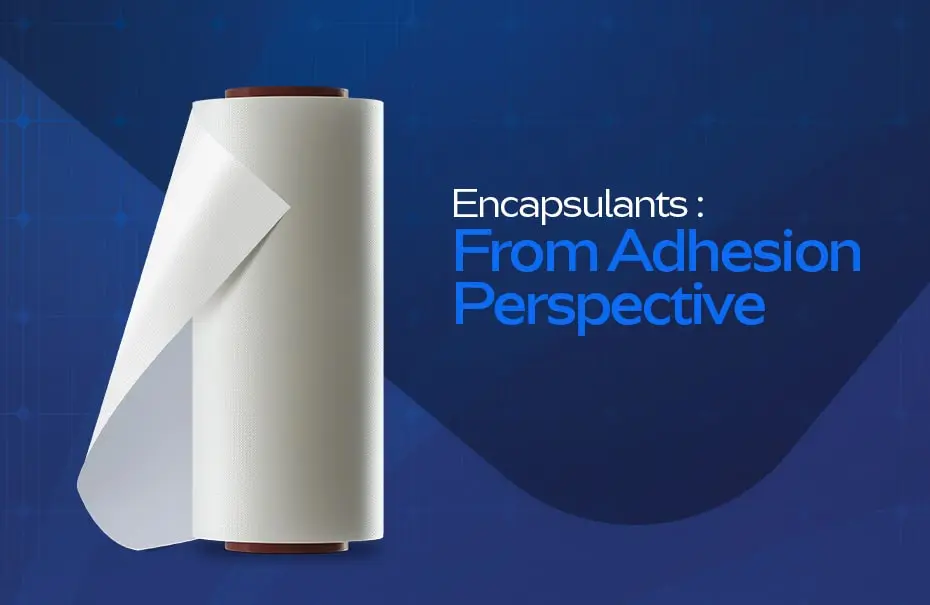Know About Encapsulant Adhesion in Solar Panel

An encapsulant EVA (Ethylene Vinyl Acetate) is a key component in the production of photovoltaic (PV) modules. It offers excellent optical, electrical, and mechanical properties, making it ideal for use in solar panels. It works as a layer that covers and protects the solar cells, providing a durable and long-lasting barrier that shields the cells from environmental factors such as moisture, dust, and physical damage. The encapsulant is applied to the top and bottom of the solar cells to retain their efficiency at the module level. The Solar cells are sandwiched between encapsulants which forms a hermetic seal that protects the solar cells from moisture and other environmental factors.
What is Adhesion in Encapsulant?
Adhesion refers to the ability of the encapsulant to bond strongly to both the solar cells and the front and back sheets that make up the module. This is essential to ensure that the module remains stable and secure, even when exposed to extreme weather conditions, such as high winds and heavy rain.
Factors Affecting Encapsulant Adhesion
There are several factors that determine the adhesion properties of an EVA encapsulant, including its chemical composition, thickness, and curing conditions. The chemical composition of the encapsulant plays a significant role in determining its adhesion properties, as it influences the molecular structure of the material and its ability to bond with other materials. The thickness of the encapsulant is also important, as a thicker layer generally provides better adhesion than a thinner layer. However, it is important to balance the benefits of improved adhesion with the potential for increased stress on the solar cells, which can lead to cracking and reduced efficiency. Curing conditions, such as temperature and pressure, also play a critical role in the adhesion properties of the encapsulant. During the curing process, the encapsulant undergoes a chemical reaction that causes it to bond with the other materials in the module. The optimal curing conditions will depend on the specific composition of the encapsulant, as well as the design and construction of the module.
Functions of Encapsulant
Protects solar cells
One of the most important functions of the encapsulant is to prevent the solar cells from deteriorating due to exposure to harsh environmental conditions. Over time, high absorption of UV rays can, hamper the performance of the PV module reducing its efficiency. The encapsulant acts as a regulator for these UV rays, protecting the cells and ensuring that they remain functional for a longer period.
Strengthens solar module
Encapsulant in solar panel keeps the efficiency of the solar cells intact. When light enters the solar panel, it is absorbed by the cells and converted into electrical energy. Higher absorption of encapsulants makes it possible to retain the efficiency of cells at module level, lowering the CTM loss.
Stabilizes solar cells
The encapsulant also improves the mechanical stability of the solar panel. Solar panels are subject to a range of mechanical stresses, including wind, hail, and thermal cycling. The encapsulant helps to distribute these stresses across the surface of the panel, reducing the likelihood of damage or failure.
Types of Solar Encapsulants
Currently, there are two main types of encapsulant used in solar panels: EVA and polyolefin (POE).
EVA Encapsulant
is the most commonly used material, and it has been used in solar panels for several decades. It is a highly transparent material that offers excellent adhesion to glass and solar cells. It is also highly resistant to UV radiation and has a low water vapor transmission rate (WVTR).
Polyolefin
This is a newer type of encapsulant that has gained popularity in recent years. It is a more environmentally friendly material than EVA and has a higher resistance to moisture and temperature changes. It offers excellent PID resistance, very low WVTR and exceptionally high transmittance.
Challenges of EVA Encapsulant
One of the key challenges in developing an EVA encapsulant with strong adhesion properties is balancing the need for adhesion with other desirable properties, such as flexibility and durability. A highly adhesive encapsulant may be prone to cracking and delamination over time, especially if it is exposed to a wide range of environmental conditions.
To address this challenge, manufacturers typically use a combination of materials and techniques to enhance the adhesion properties of the encapsulant while also maintaining other desirable properties. For example, some encapsulants may include additives that improve their bonding properties while also increasing their flexibility and resistance to environmental factors.
In addition to improving the adhesion properties of the encapsulant itself, module manufacturers also take steps to ensure that the other components of the module are designed and constructed to maximize adhesion. This includes using materials that are compatible with the encapsulant and optimizing the design of the module to minimize stress on the encapsulant and solar cells.
Conclusion
In conclusion, encapsulant is a critical component of a solar panel that plays a vital role in protecting the solar cells. It is a thin, transparent layer that is applied to the top and bottom of the solar cells to protect them from environmental damage and improve their mechanical stability. There are two main types of encapsulant used in solar panels: EVA and polyolefin. Both materials offer excellent protection and improve the efficiency of solar panels, but polyolefin is a more environmentally friendly material and has a higher resistance to PID, moisture and temperature changes.
